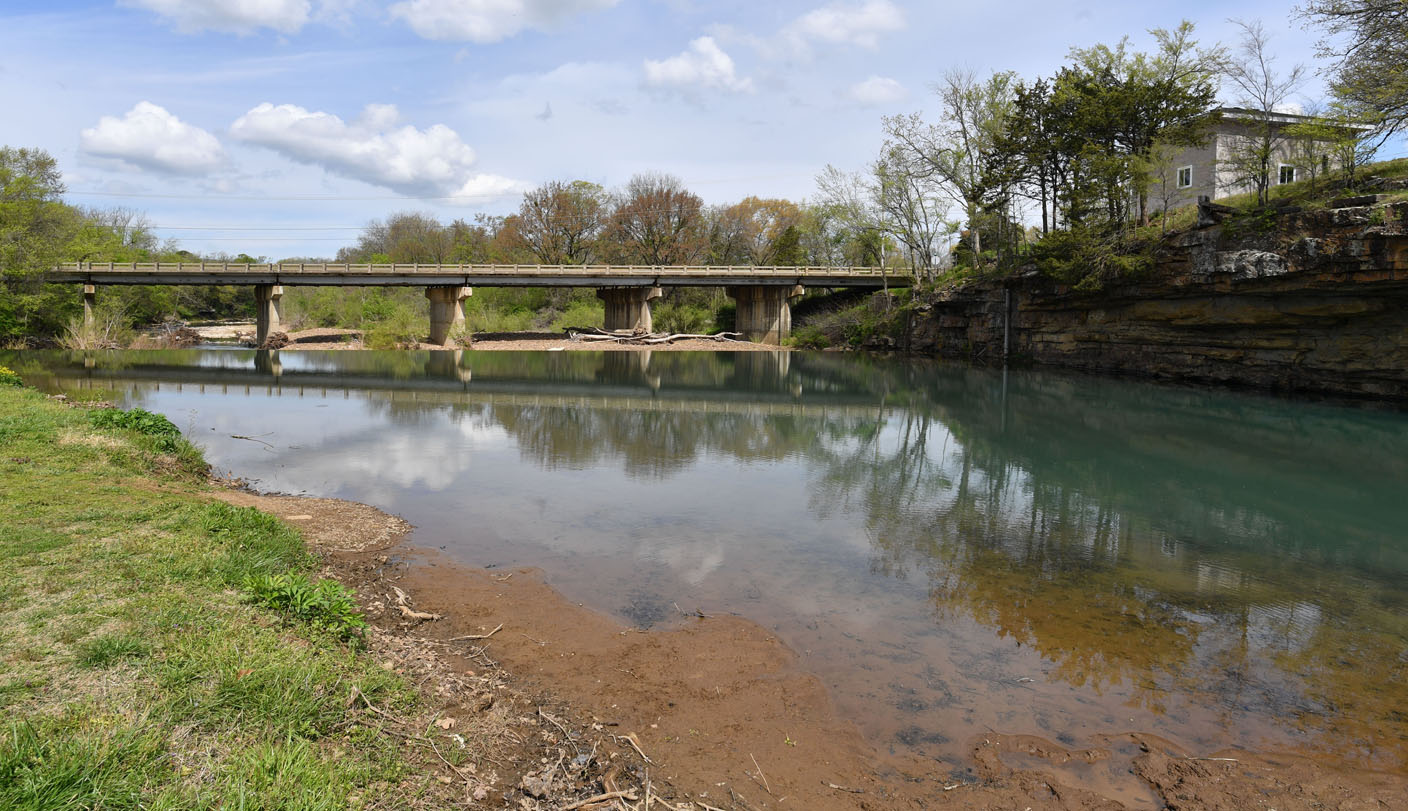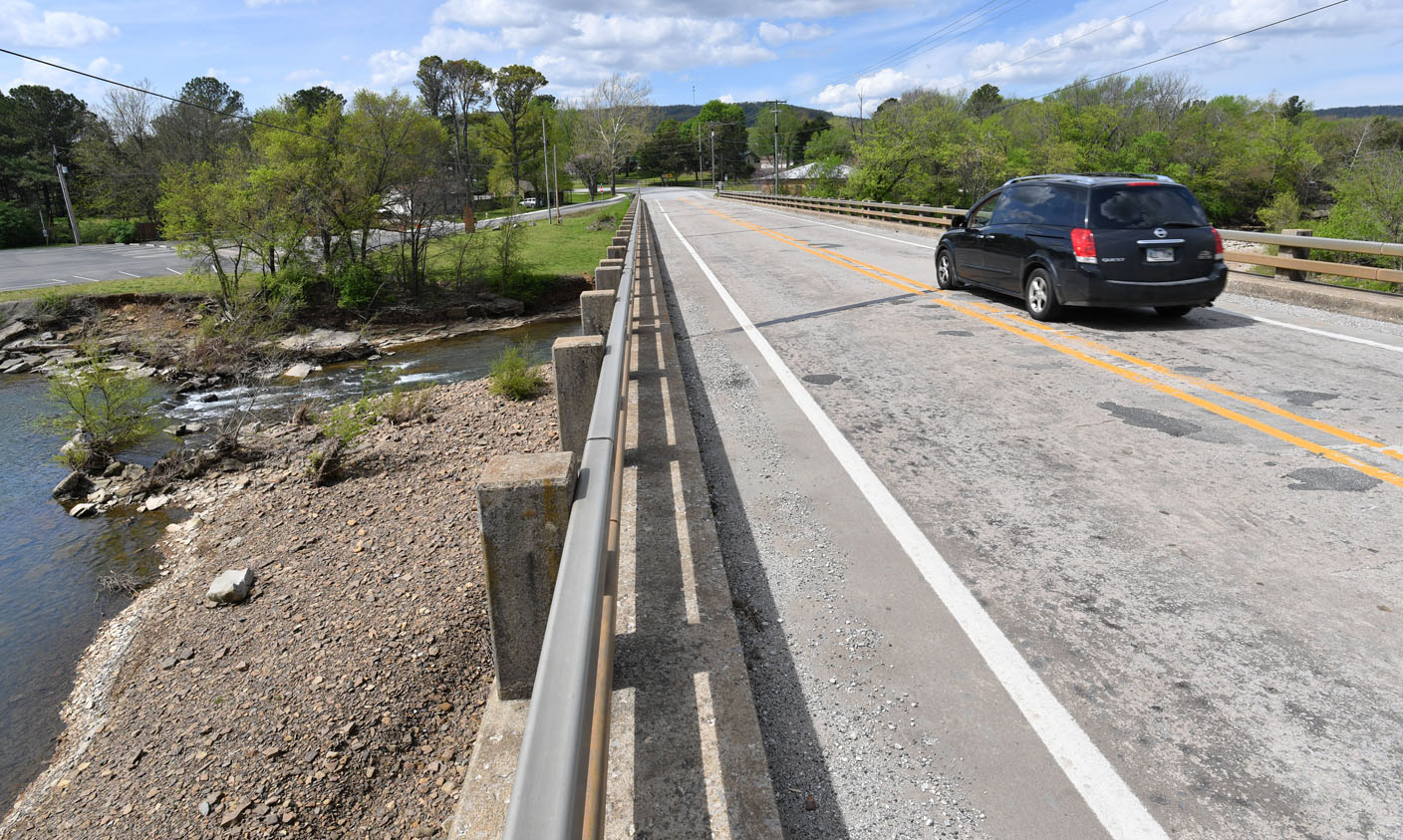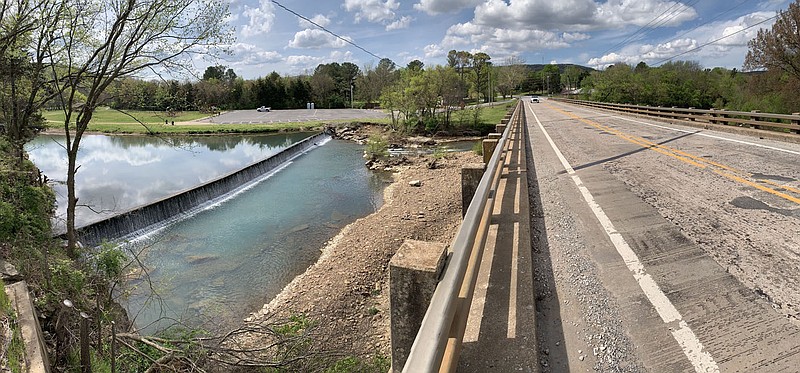West Fork wanted a new bridge to replace the aging structure that carries Main Street over the West Fork of the White River next to Centennial Park, a popular swimming hole.
So it struck a partnership with the Arkansas Department of Transportation to speed up the process, a growing trend in the region under the agency’s partnership program.
West Fork passed a resolution Feb. 22 to partner with the department, which owns the bridge, and the agency added the job to its list of projects, according to Chad Adams. Adams heads up Division 4 for the Transportation Department, which includes Washington County.
“So we are still in the very early stages,” Adams said. “We are currently targeting 2026 for this work.”
Mayor Heith Caudle said the city will get its bridge and, in exchange, will take over future maintenance of the bridge and Arkansas 170, Main Street, through the city.
“It’s been something that we’ve been needing for a while. We’d been trying to get some traction for quite some time going through normal channels, and we weren’t getting anywhere,” Caudle said. “The state wasn’t interested.”
Caudle said a friend with Brown and McDonald, an engineering firm, introduced him to the partnership program and offered to pitch the project to the department, free of charge.
Within 60 days, the department said it was interested in partnering, Caudle said.
“Our original bridge design was a three-lane bridge with pedestrian paths on both sides. The state said there’s no way in the world they’re going to build a bridge like that in West Fork,” Caudle said. “So, we compromised, and we are getting a two-lane bridge with a 10-foot walkway on the north side of it.”
Caudle said the existing bridge was built in the late 1960s and is reaching the end of its life. He expects to see the state start survey work on the project in the summer.
“It’s been in bad shape. That deck on it, every time it rains it opens the pot holes,” Caudle said, adding maintenance on the bridge is “almost a full-time project.”
Caudle said because of the partnership program, the city won’t spend any money building a new bridge.
“What the partnership is, is we are going to take possession of Highway 170 from Interstate 49 to Highway 71,” Caudle said. “They will basically do some improvements to that strip of road. They will replace the bridge with a new bridge and after that, maintenance of that piece of road will fall on the city of West Fork.”
Caudle said it’s similar to the agreement Fayetteville made on U.S. 71B and Farmington made on U.S. 62B through those cities, which takes the roads off the state’s plate, giving it fewer miles to maintain.
The agreement will also free the city to make some other improvements on the street, Caudle said.
“As it stands, if we want to do sidewalk improvements or anything like that, we’ve gotta go through the state authorities just to get permission to put a sidewalk within so many feet of it. There are some drainage issues that have been problems forever that the city can’t fix,” Caudle said. “It’s going to give us the opportunity to do some things that really need to be done on that strip of road anyway and potentially better maintain it.”
Caudle said a safe way for pedestrians to cross the bridge is also badly needed.
Owning the bridge does have one potential downside, he said.
“The only scary part is in 50 years, the citizens of West Fork are going to have to figure out how to replace that bridge,” Caudle said. “Whatever its lifespan is, that’s going to fall on the city the next time it gets replaced. To me, that’s the only downside, and we hope that we’d have enough economic growth between now and then to be able to replace it.”
Everyone benefits
Jared Wiley, assistant chief engineer for planning at the Arkansas Department of Transportation, said the partnering program, which began in the 1990s, speeds up the process and makes the department’s money go further. It also provides incentives to local entities to participate and get projects done.
Highway projects using federal money typically require a 20% state match, Wiley said. The partnering program has allowed the department to partner with entities that have a little bit of cash to bring to the table, Wiley said.
“It accelerates projects because with the limited revenue that we’ve had, historically, a project would have to wait until the funding becomes available,” Wiley said. “A lot of times partnering funding puts us over that fiscal hump, and we’re able to begin project development” much earlier, he said.
Wiley said today, the partnering program also gets $25 million a year from a dedicated road tax passed by state voters in 2020.
Wiley said there’s no one-size-fits-all partnership; they’re all different. Sometimes it’s cash. Several counties have passed local sales taxes to help fund projects. Other times, it may be a city will take over maintenance of a road, removing it from the state system, which is the case in West Fork.
“That really helps us long-term,” Wiley said, adding because Arkansas has the 12th largest highway system in the country, “any relief we can get there certainly helps.”
Northwest Arkansas leads other areas in the state when it comes to partnering with the department.
“Traditionally, we’ve seen a lot of interest in partnering from our friends in Northwest Arkansas,” Wiley said. “I think it’s just a matter of they have a lot of needs up there with the population growth they’ve seen over the past few decades, and they have been willing to contribute to projects to try to expedite the work that needs to be done.”
Tim Conklin, executive director at the Northwest Arkansas Regional Planning Commission, concurred.
Projects around the region that have seen, or are currently undergoing, such partnerships include: improvements to U.S. 71B/Walnut Street in Rogers, U.S. 71B/College Avenue in Fayetteville, U.S. 62B in Prairie Grove, the J Street interchange in Bentonville, Arkansas 170 in Farmington and Arkansas 12/Arkansas 59 in Gentry.
Older projects included Arkansas 265 through several cities on the east side of the metro area.
“All four major Northwest Arkansas cities have all stepped up with local funds to advance ARDOT projects to improve mobility within their city and throughout the region,” Conklin said.
According to the latest data available, Bentonville, Rogers, Fayetteville, Springdale and Fort Smith were all in the top 10 of cities partnering with the Transportation Department on projects. Farmington was just outside the top 10. Other cities around the area partnering on projects include Greenwood, Siloam Springs, Centerton, Harrison, Lowell, Alma, Bella Vista, West Fork, Eureka Springs and Barling.
Bentonville has partnered more than any city in the state, contributing more than $74 million to nine projects, which was about 54% of the total costs. Rogers has contributed more than $30.6 million on six projects, about 34% of the total costs. Fayetteville has paid more than $28 million toward 14 projects, about 10% of the costs. Springdale has put more than $23.8 million toward four projects, about 44% of the costs.
“There’s just many examples of all the large cities in Northwest Arkansas looking at how to advance these projects and improve these projects to add bicycle and pedestrian facilities, improve safety on the roadways,” Conklin said. “A lot of these roadways were two-lane, open ditch, little to no shoulders on them.”
Conklin said the region is unique in that it has been adding about 100,000 people per decade for the last 30 years and there’s no sign of that slowing. The region is forecast to have about a million people by 2045.
Conklin said the population growth is spilling over to the region’s smaller cities.
“Many of these cities understand that to move some of these projects forward, they’re going to need to partner to address some of these transportation issues that we have,” he said.
Statewide, cities, counties and other entities have partnered on 145 projects with local contributions exceeding $383.8 million. More than 160 miles have been removed from the state highway system.
 Water flows Thursday, April 13, 2023, beneath the bridge over the West Fork of the White River along Main Street in West Fork. The city of West Fork is working with the Arkansas Department of Transportation to replace the bridge with work set to begin in 2026. Visit nwaonline.com/photo for today's photo gallery. (NWA Democrat-Gazette/Andy Shupe)
Water flows Thursday, April 13, 2023, beneath the bridge over the West Fork of the White River along Main Street in West Fork. The city of West Fork is working with the Arkansas Department of Transportation to replace the bridge with work set to begin in 2026. Visit nwaonline.com/photo for today's photo gallery. (NWA Democrat-Gazette/Andy Shupe)
 Traffic passes over the bridge spanning the West Fork of the White River Thursday, April 13, 2023, along Main Street in West Fork. The city of West Fork is working with the Arkansas Department of Transportation to replace the bridge with work set to begin in 2026. Visit nwaonline.com/photo for today's photo gallery. (NWA Democrat-Gazette/Andy Shupe)
Traffic passes over the bridge spanning the West Fork of the White River Thursday, April 13, 2023, along Main Street in West Fork. The city of West Fork is working with the Arkansas Department of Transportation to replace the bridge with work set to begin in 2026. Visit nwaonline.com/photo for today's photo gallery. (NWA Democrat-Gazette/Andy Shupe)
On the web
Arkansas Department of Transportation partners list at: nwaonline.com/416ardot/

